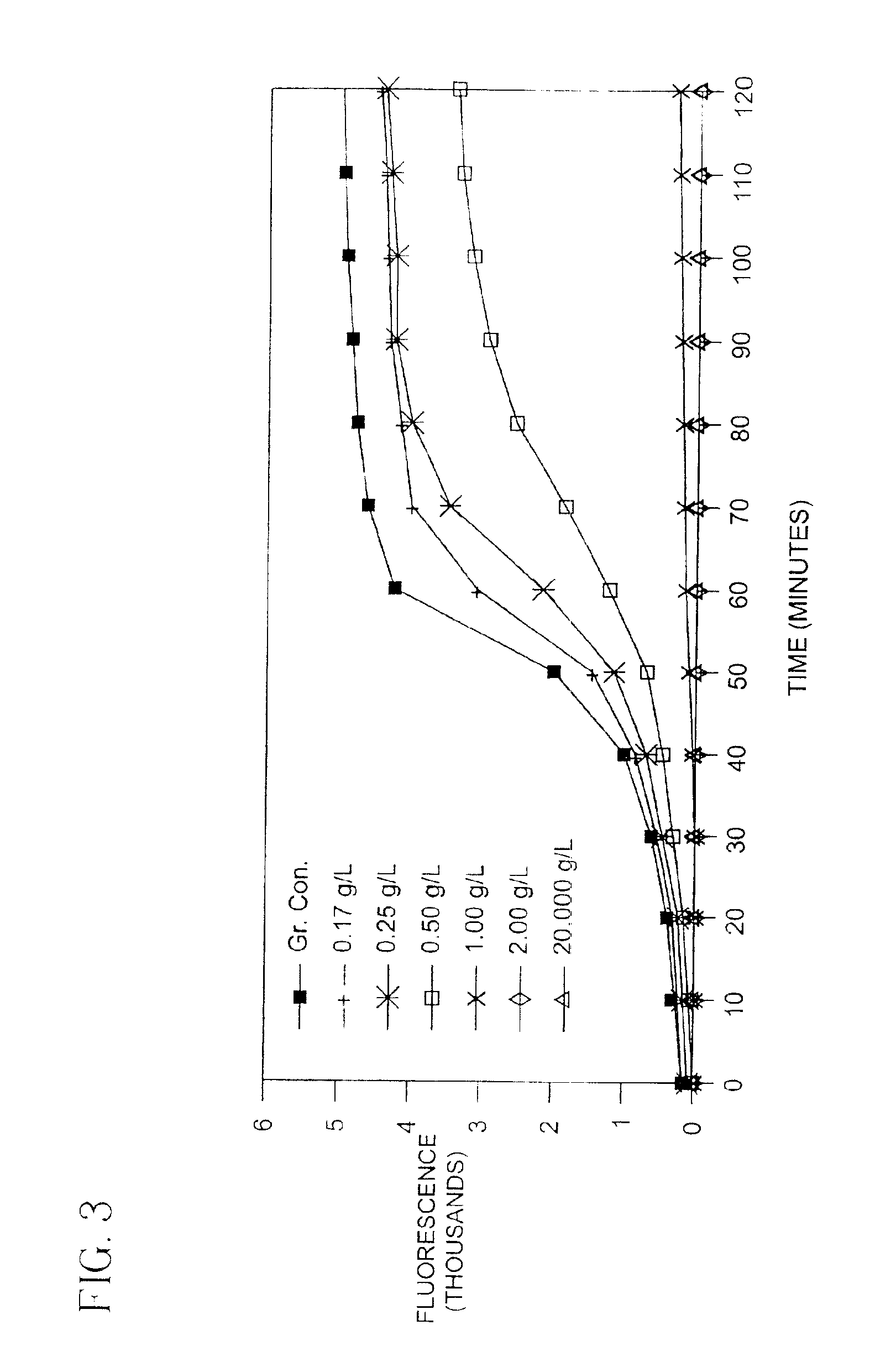Device for monitoring cells
a cell and cell technology, applied in the field of cell monitoring devices, can solve the problems of requiring a long incubation period, affecting the detection, identification and analysis of the behavior of microorganisms, and many procedures still time-consuming and laborious
- Summary
- Abstract
- Description
- Claims
- Application Information
AI Technical Summary
Benefits of technology
Problems solved by technology
Method used
Image
Examples
example 1
Preparation of an O2-Sensitive Indicator Microtitration Tray
[0081]The fluorescent compound tris 4,7-diphenyl-1,10-phenanthroline ruthenium (II) chloride (Ru(DPP)3Cl2) was synthesized using the procedure of Wafts and Crosby (J. Am. Chem. Soc. 93, 3184(1971)). A total of 3.6 mg of the compound was dissolved in 2.0 ml dimethyl sulfoxide (D-5879, Sigma Chemical, St. Louis, Mo.) and the resultant solution was then added slowly, with stirring, to 1300 ml silicone rubber forming solution (Water Based Emulsion #3-5024, Dow Corning, Midland, Mich.). A 35 microliter aliquot of the mixture was subsequently dispensed into each well of a 96 well, flat bottom, white microtiter tray (#011-010-7901, Dynatech, Chantilly, Va.), and the system was subsequently cured overnight in a low humidity (less than 25% RH), 60° C. incubator. After curing, the trays were washed by either soaking or by filling and emptying each well several times with each of the following reagents; a) absolute ethanol, b)0.1 M ph...
example 2
Use of Indicator System to Measure Relative O2 Concentration Produced by a Reducing Agent
[0086]The O2 concentration in wells of an Indicator Microtiter tray produced as in Example 1 was varied by the addition of a strong reducing agent, sodium sulfite (which reduces O2 content). A 150 microliter aliquot of the reducing agent (at concentrations ranging from 0 to 1083 parts per million (ppm) sulfite ion in water) was pipetted into wells of the tray. Each well was allowed to react for 30 minutes, open to the atmosphere, and the fluorescence of the indicators measured in a Fluoroskan II Fluorometer (Flow Laboratories, McLean, Va.), having an excitation bandpass filter at a wavelength of 460 nm and an emission cut-on filter at 570 nm. The results are presented in Table 2.
[0087]
TABLE 2Effect of Sodium Sulfite on Fluorescenceppm sulfite ionFluorescence Intensity*030906535131633545325403354211571108311863*Mean of 4 wells
[0088]As shown, the wells containing the highest concentrations of red...
example 3
Use of Indicator System to Determine the Presence of a Microorganism
[0089]A 0.5 McFarland suspension of E. coli (ATCC #25922), containing about 1.5×108 CFU / ml, was prepared using an A-Just nephelometer (Abbott Labs, Chicago, Ill.). The suspension was diluted to about 1×107 CFU / ml in Broth A (see Example 1). A 150 microliter aliquot of this suspension was placed into indicator tray wells prepared as in Example 1, and subsequently incubated at 37° C. At intervals, the fluorescence was measured in a Fluoroskan II fluorometer over the period of 1-3½ hours. An increased fluorescence signal was observed over time as shown in FIG. 1. The fluorescence signal from wells containing no organisms showed very little change. The wells containing organisms were significantly brighter when visually observed under a UV light source. Thus, it appears that the metabolic activity of the organisms in the wells caused the fluorescence signal to increase (presumably by decreasing the O2 concentration).
PUM
| Property | Measurement | Unit |
|---|---|---|
| elapsed time | aaaaa | aaaaa |
| elapsed time | aaaaa | aaaaa |
| time period | aaaaa | aaaaa |
Abstract
Description
Claims
Application Information
 Login to View More
Login to View More - R&D
- Intellectual Property
- Life Sciences
- Materials
- Tech Scout
- Unparalleled Data Quality
- Higher Quality Content
- 60% Fewer Hallucinations
Browse by: Latest US Patents, China's latest patents, Technical Efficacy Thesaurus, Application Domain, Technology Topic, Popular Technical Reports.
© 2025 PatSnap. All rights reserved.Legal|Privacy policy|Modern Slavery Act Transparency Statement|Sitemap|About US| Contact US: help@patsnap.com



